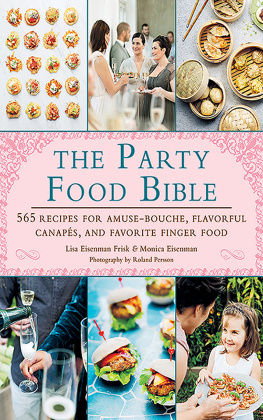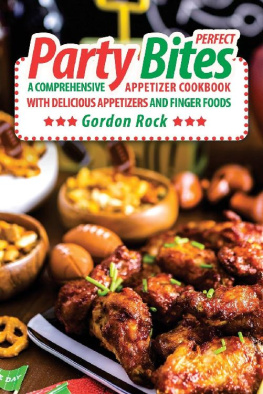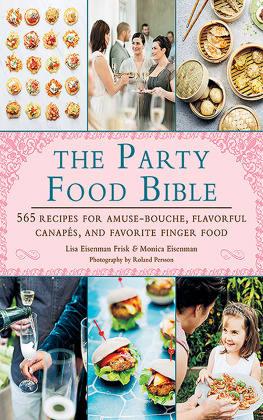THE PARTY
FOOD BIBLE


THE PARTY
FOOD BIBLE
565 RECIPES FOR AMUSE-BOUCHES, FLAVORFUL
CANAPS, AND FESTIVE FINGER FOOD Lisa Eisenman Frisk & Monica Eisenman Photography by Roland Persson
Translated by Anette Cantagallo

SKYHORSE PUBLISHING

CONTENTS


FOREWORD

As children growing up in a suburb of Washington, DC, we often found ourselves perched at the top of the foyer staircase, captivated by the stylish guests who arrived for one of our parents many dinner parties. This being the 1970s, hip-hugging slacks and splashy wide-collared shirts abounded. Our Swedish mother and American father came from different backgrounds and customs, but one thing they shared was a gift for entertaining friendsfrom cocktail parties to outdoor barbecues to formal dinners. Once, they even hosted a backwards soire, kicked off with dancing, port wine, and dessert, followed by a three-course meal, and concluding with appetizers and aperitifs! These festivities instilled in us a similar passion for food and entertaining, and its this love that inspired this book. Featuring 565 recipes from around the world, here you will find savory and sweet hand-held treats for virtually any occasionfrom baby showers, to graduation parties, or simply potluck gatherings with family and friends.



PARTY PLANNING
 Planning ahead makes for a successful party.
Planning ahead makes for a successful party.
The small details are what add up to a festive whole, and advance preparations will make the event more enjoyable for both you and the guests. Here are some tips on how to best organize a fantastic gathering. WHAT KIND OF PARTY? What sort of event are you hosting? Will it be casual, formal, simple, or extravagant? Will finger foods and drinks be the main event, or will there be seating for dinner afterward? There are many enticing ways to invite people to a partyfrom fancy cards on elegant paper to whimsical emails. Be clear about the nature of the event, so guests know what to expect. It can also be fun if the gathering has an overarching theme, which can be introduced in the invitation. WHERE WILL THE PARTY BE HELD? Regardless of where the party will be located, its important to know the conditions of the premises.
They should be neither too compact nor so roomy that the space feels empty. Is there a good kitchen with heating and cooling appliances? If the location is difficult to find, provide clear directions in the invitation. If the party is outdoors, make contingencies for bad weather. Large tents can protect against sun, wind, and rain. For chilly evenings, consider renting propane heaters or buying inexpensive blankets to keep guests warm. Also, keep in mind that there may be uninvited intruders, such as mosquitoes, flies, and wasps! Many people appreciate knowing whether a garden party will be held on the lawn or on a wooden deck, so they can choose suitable shoes and wont risk destroying their delicate high heels.
If the party will inconvenience neighbors, consider notifying them in advance and letting them know how long it will last. WHAT TO SERVE? An essential feature of a successful party is a well-considered and composed menu, including a range of flavors, aromas, consistencies, and colors. Mix things up and avoid repeating the same seasonings and ingredients in different dishes. Strive for a balance between sweet and savory, mild and spicy. See proposed menus on page 306. Offer a variety of dishes that will appeal to all guests: meat, fish, and vegetarian.
Some people are adventurous eaters, whereas others are more conservative. Also bear in mind common food allergies. For large gatherings, try to avoid preparing completely untested recipes. With that said, dont be afraid to try new dishes combined with classic favorites. Let the season inspire the menu. Fresh, local ingredients usually taste best, and are often the cheapest and easiest to obtain.
Serve hot and cold dishes. In winter, steaming food warms the belly, and in summer, cool dishes are refreshing. What kind of cooling and warming appliances are available? How long will the food be left out? Consider serving a few dishes that do not need to be refilled and can stay out for a couple hours. Serve something sweet for dessert. Even if handheld snacks are the primary food (rather than a seated dinner) desserts are always appreciated! HOW MUCH TO PREPARE? As long as there is plenty to eat and drink, the party will be a hit. Its always better to have too much than too little, and it all too often happens that hosts or hostesses underestimate guests appetites! But determining how much food is needed can be difficult.
There are several things to consider.  WHAT SEASON IS IT? Generally, we eat more in winter than in summer.
WHAT SEASON IS IT? Generally, we eat more in winter than in summer.  WHAT TIME IS THE PARTY? When did guests last eat? Are they coming straight from work, or have they traveled from far away? Is the party being held during a traditional mealtime?
WHAT TIME IS THE PARTY? When did guests last eat? Are they coming straight from work, or have they traveled from far away? Is the party being held during a traditional mealtime?  HOW ARE THE PARTY PREMISES? If the space is crowded, it can be difficult for serving staff to move and for guests to access food tables, resulting in people eating less.
HOW ARE THE PARTY PREMISES? If the space is crowded, it can be difficult for serving staff to move and for guests to access food tables, resulting in people eating less.  WHO ARE THE GUESTS? Close friends and family will often have no difficulty indulging in the food you serve, whereas acquaintances and professional colleagues may be more reserved. At a formal event, people tend to be more restrained and eat less. Men consume more than women, and the elderly tend to eat less than the young.
WHO ARE THE GUESTS? Close friends and family will often have no difficulty indulging in the food you serve, whereas acquaintances and professional colleagues may be more reserved. At a formal event, people tend to be more restrained and eat less. Men consume more than women, and the elderly tend to eat less than the young.
Calculate at least one serving per guest for each dishbut preferably more, because guests are sure to want to taste each dish and will happily take second and third helpings. Keep finger food, such as roasted nuts and dried fruit, available as a backup; theyre easy to serve and are quite filling. Dont try to impress your guests by offering as many kinds of foods as possibletheres always the risk that youll take on more than you can handle. Rather, select a few dishes, do them well, and prepare more than enough. PLATING AND SERVING Consider how colors, shapes, and choices of food and drink can be combined, and how to arrange the dishes and the table settings. Everything looks more appetizing on attractive plates, serving trays, and in beautiful bowls.














 SKYHORSE PUBLISHING
SKYHORSE PUBLISHING 


 As children growing up in a suburb of Washington, DC, we often found ourselves perched at the top of the foyer staircase, captivated by the stylish guests who arrived for one of our parents many dinner parties. This being the 1970s, hip-hugging slacks and splashy wide-collared shirts abounded. Our Swedish mother and American father came from different backgrounds and customs, but one thing they shared was a gift for entertaining friendsfrom cocktail parties to outdoor barbecues to formal dinners. Once, they even hosted a backwards soire, kicked off with dancing, port wine, and dessert, followed by a three-course meal, and concluding with appetizers and aperitifs! These festivities instilled in us a similar passion for food and entertaining, and its this love that inspired this book. Featuring 565 recipes from around the world, here you will find savory and sweet hand-held treats for virtually any occasionfrom baby showers, to graduation parties, or simply potluck gatherings with family and friends.
As children growing up in a suburb of Washington, DC, we often found ourselves perched at the top of the foyer staircase, captivated by the stylish guests who arrived for one of our parents many dinner parties. This being the 1970s, hip-hugging slacks and splashy wide-collared shirts abounded. Our Swedish mother and American father came from different backgrounds and customs, but one thing they shared was a gift for entertaining friendsfrom cocktail parties to outdoor barbecues to formal dinners. Once, they even hosted a backwards soire, kicked off with dancing, port wine, and dessert, followed by a three-course meal, and concluding with appetizers and aperitifs! These festivities instilled in us a similar passion for food and entertaining, and its this love that inspired this book. Featuring 565 recipes from around the world, here you will find savory and sweet hand-held treats for virtually any occasionfrom baby showers, to graduation parties, or simply potluck gatherings with family and friends. 


 WHAT SEASON IS IT? Generally, we eat more in winter than in summer.
WHAT SEASON IS IT? Generally, we eat more in winter than in summer.